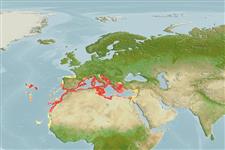>
Gadiformes (Cods) >
Phycidae (Phycid hakes)
Etymology: Phycis: Taken from Greek, phykon = seaweed; because of the habits of this fish that lives hidden among them (Ref. 45335).
More on author: Linnaeus.
Environment: milieu / climate zone / depth range / distribution range
Ecologie
marien benthopelagisch; standvastig; diepte 13 - 614 m (Ref. 4517), usually 100 - 200 m (Ref. 1371). Subtropical; 45°N - 13°N, 32°W - 36°E
Northeast Atlantic : Bay of Biscay to Morocco, south to Cape Verde, and including off-lying islands. Also in the Mediterranean and the Azores.
Lengte bij maturiteit / Grootte / Gewicht / Leeftijd
Maturity: Lm 36.0, range 32 - ? cm
Max length : 65.0 cm TL mannelijk / geslacht onbekend; (Ref. 12382); common length : 25.0 cm TL mannelijk / geslacht onbekend; (Ref. 1371); max. gepubliceerd gewicht: 3.9 kg (Ref. 40637)
Dorsale stekels (totaal) : 0; Anale stekels: 0. Elongated pelvic-fin rays reaching at most to the origin of the anal fin. Body color is brownish-red dorsally, becoming paler ventrally. Vertical fins distally dark, sometimes with a pale margin.
Found on hard and sandy-muddy bottoms near rocks at 100-650 m, but sometimes taken at greater depths (Ref. 1371). Nocturnal, hiding between rocks during the day (Ref. 1371). Feed on small fish and various invertebrates (Ref. 1371).
Cohen, D.M., T. Inada, T. Iwamoto and N. Scialabba, 1990. FAO species catalogue. Vol. 10. Gadiform fishes of the world (Order Gadiformes). An annotated and illustrated catalogue of cods, hakes, grenadiers and other gadiform fishes known to date. FAO Fish. Synop. 125(10). Rome: FAO. 442 p. (Ref. 1371)
Status op de Rode Lijst van het IUCN (Ref. 130435)
Gevaar voor de mens
Harmless
Gebruik door de mens
Visserij: van minder commercieel belang
Tools
Speciale rapporten
Download XML
Internetbronnen
Estimates based on models
Preferred temperature (Ref.
123201): 13.3 - 16.2, mean 14.9 °C (based on 84 cells).
Fylogenetische diversiteitsindex (Ref.
82804): PD
50 = 0.6255 [Uniqueness, from 0.5 = low to 2.0 = high].
Bayesian length-weight: a=0.00631 (0.00523 - 0.00762), b=3.15 (3.09 - 3.21), in cm total length, based on LWR estimates for this species (Ref.
93245).
Trofisch niveau (Ref.
69278): 4.3 ±0.3 se; based on diet studies.
Weerstandsvermogen (Ref.
120179): Gemiddeld, minimale populatieverdubbelingstijd 1,4-4,4 jaar (K=0.19).
Fishing Vulnerability (Ref.
59153): Moderate vulnerability (45 of 100).
Climate Vulnerability (Ref.
125649): High to very high vulnerability (68 of 100).
Nutrients (Ref.
124155): Calcium = 37 [17, 84] mg/100g; Iron = 0.74 [0.40, 1.34] mg/100g; Protein = 18.1 [16.8, 19.5] %; Omega3 = 0.386 [0.203, 0.736] g/100g; Selenium = 44.8 [21.7, 90.3] μg/100g; VitaminA = 15.9 [4.6, 56.9] μg/100g; Zinc = 0.586 [0.383, 0.881] mg/100g (wet weight);
